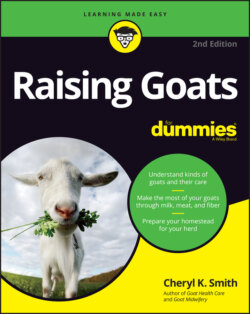Читать книгу Raising Goats For Dummies - Cheryl K. Smith - Страница 40
Teeth
ОглавлениеGoats have lower teeth in the front of their mouths but only a hard pad on the top. They also have back teeth on both top and bottom, which you will painfully discover if you put your finger into the back of a goat’s mouth! The back teeth are used for cud-chewing.
Baby goats get their first teeth before birth, at around 98 to 105 days of gestation. They lose these baby teeth, just like other mammals. You can generally determine the age of a goat by looking at the eight teeth in the goat’s lower front jaw. This is called toothing a goat.
Toothing a goat is not completely accurate because you can find variances among goats. They may lose some teeth and grow new ones at different times, or their diet or health can influence how their teeth grow. Figure 2-3 shows you goats’ teeth at various stages.
Here’s a guide to toothing a goat:
First year (kid): Baby teeth are small and sharp. They gradually fall out and permanent teeth replace them.
Second year (yearling): The two middle front teeth fall out when the kid is about 12 months old. Two larger permanent teeth grow in their place.
Third year: The teeth next to the two middle teeth fall out. Two new, larger, permanent teeth grow in when the kid is about 24 months old.
Fourth year: The next two teeth on either side of the four middle teeth fall out, and new permanent teeth grow in.
Fifth year: The goat has all eight front teeth.After five years, you can guess at the goat’s age by looking for wear on the teeth and missing teeth. This will vary a lot, depending on the goat’s diet.
FIGURE 2-3: You can tell a goat’s age by his teeth.
